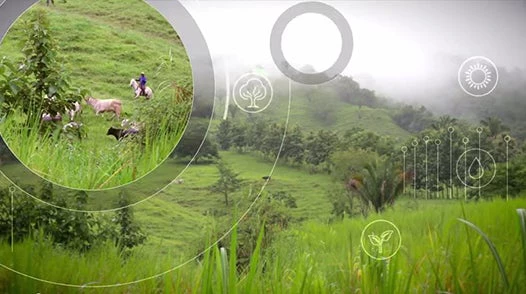
Agriculture is central to feeding the world and reducing poverty.
But conventional forms of agriculture are often unsustainable and drive land degradation. Agriculture is also the world’s leading anthropogenic source of methane (52 percent) and nitrous oxide (84 percent) emissions, and the principal driver of deforestation worldwide. Agriculture and agriculture-driven land-use change contribute 24 percent of global greenhouse gas emissions.
We can’t fix what we don’t measure, which is why quantifying greenhouse gas emissions from agricultural production is a necessary step for climate-smart agriculture (CSA). Greenhouse gas accounting can provide the numbers and data that are important to solid decision making.
It will help identify management practices and opportunities that reduce greenhouse gas emissions while also providing improved food security, more resilient production systems, and better rural livelihoods. In practical terms, greenhouse gas emissions data can support farmers in adopting less carbon-intensive practices, guiding low-emissions development, assessing product supply chains, certifying sustainable agriculture practices, and informing consumers on the carbon footprint of their choices.
While greenhouse gas emissions data are useful for mainstreaming climate-smart agriculture, implementing greenhouse gas accounting is fraught with several challenges. One major challenge is the lack of functional tools that people can actually use: Tools that work across scales and agricultural land use systems, help prioritize mitigation actions and are flexible when it comes to requirements for country-specific data. Useful greenhouse gas accounting tools should include confidence thresholds in greenhouse gas emission estimates and offer understandable metrics for tracking greenhouse gas emissions. Equally important is the need to build technical capacity in land use monitoring and greenhouse gas accounting, especially in developing countries.
To address these challenges, the World Bank recently partnered with the FAO to develop the EX- Ante Carbon Accounting Tool (EX-ACT) and an e-learning course for greenhouse gas accounting in agricultural landscapes.
EX-ACT is a land-based accounting system used to measure and to project changes to the carbon balance over time. Carbon balance refers to the amount of carbon released into the atmosphere through emissions, relative to the amount of carbon stored in the soil and plant material of an area, and relative to the carbon that soil and plant material is actively removing or “sequestering” from the atmosphere. Emissions of greenhouse gases, which differ dramatically in the intensity of their effects on the atmosphere, are measured in terms of carbon dioxide-equivalence. The measurements are expressed in terms of tons of carbon dioxide-equivalent (tCO2-e) per hectare over a period of one year. In addition to spatial, area-based measurement, EX-ACT can also be used to measure changes to the carbon balance per unit of produce.
Ex-ante estimations of how this balance will change as the result of human activities associated with land-use change in development projects are particularly valuable in sectors that use a great deal of land, such as agriculture, forestry, pastoral livestock, and watershed management.
We’re hoping that policymakers and project managers get good use out of this tool, which is readily scalable to program and sector-wide levels, and can be used for policy analysis. It also helps project teams operationalize climate-smart agriculture, so we can begin the serious and urgent work of moving the CSA conversation from theory to action.


Join the Conversation